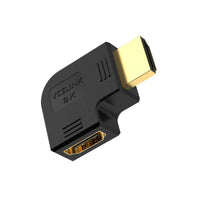An HDMI cable is usually used to connect a computer to a computer monitor or TV. HDMI cables are very common in people’s daily life. But many people are still confused about HDMI cables and connectors. What is HDMI? What is HDMI used for? What is the benefit of HDMI cables? If you have these questions, you’re right here to get what you want to know!
What is HDMI Used for?
The full name of HDMI is High-Definition Multimedia Interface, which is an audio or video interface for transmitting uncompressed digital video and audio data. HDMI cables are commonly used in AC equipment such as TVs, computers, computer monitors, home theater receivers, and game consoles.
HDMI is designed to deliver high-definition video and audio. It is often followed by a number behind to indicate the version such as HDMI 1.4, HDMI 2.0, and HDMI 2.1.

The History of HDMI
Before HDMI was created, there are several interfaces for transmitting audio and video data such as DVI and components. For example, DVI is commonly used in the past that can only transmit video signals, suitable for a computer monitor.
In the early 2000s, an idea was born to create a new standard that can be backward compatible with DVI. And HDMI was created by a group of international corporations including Hitachi, Philips, Sony, Panasonic, Silicon Image, Thomson, and Toshiba. The creation of HDMI is also supported by Disney, Warner Bros, and so on. HDMI devices have been manufactured to many versions since 2002, each of which is followed by a number such as 1.2, 1.4, or 2.0.
HDMI Versions
HDMI 1.0
HDMI 1.0 was introduced in December 2002, allowing for video and sound transmission via a single cable. It used the DVI-based link architecture but send audio and other data during the blanking intervals. HDMI 1.0 supports a transmission data up to 4.95Gb per second. It offers 3.96 Gbit/s of video information as well as 8-channel audio (192 kHz/24 bit).
HDMI 1.1
HDMI 1.1 was released in May 2004. It has made a few small adjustments and added support for DVD-Audio.
HDMI 1.2
HDMI 1.2 was introduced in August 2005. It has a lot of changes including adding an option of One Bit Audio. HDMI 1.2 standard allows the manufacturers to create formats for flexibility and made it more suitable for PC devices. It also features RGB color support. HDMI 1.2a was also introduced in 2005 and defined the CEC features, sets, and tests.
HDMI 1.3
HDMI 1.3 was an upgrading version of HDMI 1.2, which was released in 2006. The link bandwidth of HDMI 1.3 can reach a maximum bandwidth of 10.2 Gbit/s. It features a maximum video bandwidth of 8.16 Gbit/s and the support for deep colors such as 10 bpc, 12 bpc, and 16 bpc (30, 36, and 48 bit color depth). Additionally, it added HDMI Type C (Mini HDMI) for compact and portable devices. HDMI 1.3a was released in November, adding the modifications for HDMI Type C.
HDMI 1.4
HDMI 1.4 has many extra features. For example, it added an HDMI Ethernet Channel (HEC) so that two devices connected by an HDMI can share an Internet connection. In addition, HDMI 1.4 can also support 4K resolutions at 24, 25, and 30 Hz. Then, HDMI 1.4a and HDMI 1.4b was introduced separately in 2010 and 2011.
HDMI 2.0
HDMI 2.0 made a big change and it was released in 2013. HDMI 2.0 has a maximum bandwidth of up to 18.0 Gbit/s. What’s more, it has a maximum video bandwidth of 14.4 Gbit/s, which means that it can support 4K resolutions at 60Hz. It also added support for 32-channel audio. To accommodate HDR technology, HDMI 2.0a was launched, which enables more bright, clear, and natural colors.
HDMI 2.1
HDMI 2.1 is the latest version that was introduced by the HDMI Forum in 2017. The maximum transmission rate of HDMI 2.1 is 48 Gbit/s and it can support higher video resolutions and refresh rates including 8K 120Hz. HDMI 2.1 can support a resolution as high as 10K. HDMI 2.1 also has a new type of cable and to support 48 Gbit/s, you should use the new cable.

Different Types of HDMI Cables
HDMI cables can also be classified into different types according to different versions of HDMI and signal transfer speeds.
Standard HDMI Cable
Standard HDMI cable is the most basic cable that supports 1080i or 720p resolution. It is firstly designed for HDMI versions 1.0 to 1.2. And the maximum bandwidth of a standard HDMI cable can reach 4.95Gbit/s. There is also a standard HDMI cable with Ethernet, which features a data channel. And the standard HDMI automotive cable is used for vehicle video devices.
High-speed HDMI Cable
There are also high-speed HDMI cables and high-speed HDMI cables with Ethernet. Both of them support 1080p to 4k, but the latter features a data channel. This kind of HDMI cable is highly recommended for blu-ray video players.
Premium High Speed HDMI Cable
Premium high speed HDMI cable comes with the creation of HDMI 2.0. The maximum bandwidth of a premium high speed HDMI cable is 18Gbit/s. There are also premium high speed HDMI cables and premium high speed HDMI cables with Ethernet, both of which support HDR and 4k at 60Hz. Such kind of HDMI cable is great for those who love playing PC games.
Ultra High Speed HDMI Cable
A new type of cable was introduced in 2017, which is known as Category 3 HDMI or ultra high speed HDMI. The cable is made to support 4K, 5K, 8K, and 10K at 120 Hz up to 48Gbit/s. It is backward compatible with HDMI 2.0, HDMI 1.4, and so on.
HDMI Connector Types
To make the HDMI cables fit into different source devices and display equipment, they need different types of end connectors. Here are five types of HDMI connectors.
HDMI Type A
HDMI type A is commonly known as standard HDMI. HDMI type A usually features 19 pins and it can be used on common source devices such as A/V receivers, computers, game consoles, and TV monitors. Standard HDMI has the largest HDMI connector.
HDMI Type B
HDMI type B is the dual-link HDMI that was released in 2002. But this type of HDMI has never been used in consumer products.
HDMI Type C
HDMI type C is the mini HDMI connector that is a bit smaller than the standard HDMI but keeps all the functions of standard HDMI and it also features 19 pins. HDMI type C measures 10.42mm*2.42mm. It can be used in with a computer or TV monitor.
HDMI Type D
HDMI type D is well-known as a micro HDMI connector. The size of HDMI Type D is very similar to that of HDMI Type C, and this type of HDMI is very suitable for small devices such as cameras and phones.
HDMI Type E
Type E HDMI is used for automatic cables, which are specifically designed for vehicle use.

How Does HDMI Work?
HDMI encodes, transports, and decodes data or information to displays. It usually comes with 19 pins and each pin has its own function. This article will walk you through important parts of HDMI and how they function.
TMDS
It works through transition-minimized differential signaling (TMDS) technology to transmit data from one place to another place. When the data is transported in the cable from the sending devices, the data quality could be degraded and it uses TMDS to help protect the quality of signals. The encoded signals are carried by TMDS pairs of the twisted cable, of which one carries an original signal and the other carries an inverse signal to reduce interference and get the right signal. Then the signal will be sent to the receiving device and the HDMI port will identify the original and inverse signal to compensate for signal loss.
HDCP
HDMI has the function of protecting piracy. Do you know how HDMI blocks piracy content? The full name of HDCP is High-Bandwidth Digital Content Protection, which is developed by Intel. HDCP is actually an authentication protocol stored on the extended display identification data (EDID) of both sending and receiving devices. The sending device will first check the authentication key of the displaying devices and then generates a new key to share with the receiving device. The working process can also be called a handshake.
CEC
CEC (Consumer Electronics Control) is also a feature of HDMI. This allows for one controller to control up to 15 connected devices. CEC was defined in HDMI 1.0 and updated in HDMI 1.2, HDMI 1.2a, and HDMI 1.3a.
DDC
The Display Data Channel, abbreviated as DDC, is a group of protocols for communication between source devices and monitors. The source devices will identify what digital formats the monitors can handle and then adjust the parameters of the monitors.

The Benefit of HDMI
HDMI allows for both video and audio data, so you never need two different separate video and audio cables. For example, if you want to connect your computer to a monitor, you only need one cable, which makes the set-up of home entertainment more convenient. In addition, with the development of HDMI, it has the ability to transport data of 3D and Ethernet.
High-quality HDMI cables also help provide you with a good viewing experience as they can offer better audio and video quality. There are many different kinds of HDMI cables and connectors on the market to help connect your laptop, gaming console, or TV box to HDTV and other displays.
How to Choose an HDMI Cable for 4K?
4K means a horizontal display resolution of around 4,000 pixels. Nowadays, more and more families choose to purchase a 4K TV as the picture quality can be more vivid and bright. But you may be confused about choosing the right HDMI cable for a 4K TV.
The easiest way to check whether your HDMI cable is compatible with 4K is to check the logo on the cable’s package. In general, high-speed HDMI cables, premium high-speed cables, and ultra-high-speed cables can support 4K resolution. If the HDMI cable is printed with “high speed”, it is definitely suitable for 4k.
But if you don’t see the logo on the cable, remember to check the cable’s speed ratings or maximum bandwidth. It is recommended to use HDMI 2.0 for your 4K TV. The signal in 4K is transmitted at a rate of 18 Gbit/s, and the data loss is related to the length of the HDMI cable. So, when choosing the right HDMI cable for your 4K TV, remember to choose a high-performance cable of a suitable length.
FAQs
Are all the HDMI cables the same?
No, HDMI cables and connectors can be classified into different types. Type A, type C, and type D HDMI are the most common connectors in daily life. And there are standard, high speed, premium high speed, and ultra high speed HDMI cables. You should check the specification to see whether the HDMI is suitable for you.
Do all HDMI support HDR?
Not all HDMI can support HDR. HDR was introduced with the creation of HDMI 2.0, so only HDMI 2.0 and HDMI 2.1 can support HDR.
How long can HDMI cable be?
Like other cables, HDMI cables can also have a signal loss during the data transmission. In general, 50 feet is the maximum length for audio and video. But if you use an Ethernet to HDMI extender, the maximum length can reach 300 feet.
For more information on this topic, you can keep up on our blogs. While VCELINK offers general and basic information for our customers and other visitors to the website, it’s not professional advice.






Be the first one to comment.
Leave a comment